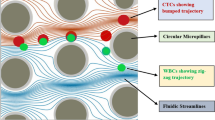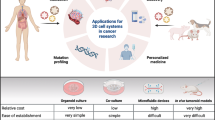Abstract
The methodical development of cell biology has resulted in significant advancements in the study of breast tumors. However, the dynamic investigation of the self-seeding process remains largely out of reach. In the present study, we describe a microvalve and liquid membrane double-controlled integrated microfluidic device that provides for the versatile assessment of breast tumor cell invasion dynamics. The liquid membrane formation was first optimized to obtain a high level of control, and was then applied to different types of homotypic and heterotypic cell seeding with precise selective positioning for monoculture and coculture. Using this device, the interaction between breast cancer cells MDA231-LM2 and MDA-MB231 was successfully observed to investigate self-seeding dynamics, including migration, infiltration, and coexistence. The results quantitatively demonstrate the mutual signal-induced attraction between MDA-MB231 and MDA231-LM2 cells, as well as the progressive infiltration of MDA231-LM2 cells into the MDA-MB231 cell population. These results are valuable in the development of spatiotemporal-controlled microfluidic systems and to many microscale-based biological and diagnostic studies involving cell growth, cell differentiation, cell interaction, and cell signal.








Similar content being viewed by others
References
Adams JC (2004) Fascin protrusions in cell interactions. Trends Cardiovasc Med 14:221–226
Berthier E, Warrick J, Casavant B, Beebe DJ (2011) Pipette-friendly laminar flow patterning for cell-based assays. Lab Chip 11:2060–2065
Bolger N, Foster M, Vinokur AD, Ng R (1996) Close relationships and adjustment to a life crisis: the case of breast cancer. J Pers Soc Psychol 70:283–294
Cai L, Zhu Y, Du G, Fang Q (2012) Droplet-based microfluidic flow injection system with large-scale concentration gradient by a single nanoliter-scale injection for enzyme inhibition assay. Anal Chem 84:446–452
Collett J, Crawford A, Hatton PV, Geoghegan M, Rimmer S (2007) Thermally responsive polymeric hydrogel brushes: synthesis, physical properties and use for the culture of chondrocytes. J R Soc Interface 4:117–126
Doran MR, Mills RJ, Parker AJ, Landmanc KA, Cooper–White JJ (2009) A cell migration device that maintains a defined surface with no cellular damage during wound edge generation. Lab Chip 9:2364–2369
Hahnfeldt P (2010) Significance of tumor self-seeding as an augmentation to the classic metastasis paradigm. Future Oncol 6:681–685
Hou HW, Li QS, Lee GYH, Kumar AP, Ong CN, Lim CT (2009) Deformability study of breast cancer cells using microfluidics. Biomed Microdevices 11:557–564
Huang X, Li L, Tu Q, Wang J, Liu W, Wang X, Ren L, Wang J (2011) On-chip cell migration assay for quantifying the effect of ethanol on MCF-7 human breast cancer cells. Microfluid Nanofluid 10:1333–1341
Jayo A, Parsons M (2010) Fascin: a key regulator of cytoskeletal dynamics. Int J Biochem Cell Biol 42:1614–1617
Jemal A, Bray F, Center MM, Ferlay J, Ward E, Forman D (2011) Global cancer statistics. CA Cancer J Clin 61:69–90
Kim U, Shu CW, Dane KY, Daugherty PS, Wang JY, Soh HT (2007) Selection of mammalian cells based on their cell-cycle phase using dielectrophoresis. Proc Natl Acad Sci USA 104:20708–20712
Kim MY, Oskarsson T, Acharyya S, Nguyen DX, Zhang XH, Norton L, Massagué J (2009) Tumor self-seeding by circulating cancer cells. Cell 139:1315–1326
Leung C, Brugge J (2009) Tumor self-seeding: bidirectional flow of tumor cells. Cell 139:1226–1228
Li A, Dawson JC, Forero–Vargas M, Spence HJ, Yu X, König I, Anderson K, Machesky LM (2010a) The actin-bundling protein fascin stabilizes actin in invadopodia and potentiates protrusive invasion. Curr Biol 20:339–345
Li L, Liu W, Wang J, Tu Q, Liu R, Wang J (2010b) Lectin-aided separation of circulating tumor cells and assay of their response to an anticancer drug in an integrated microfluidic device. Electrophoresis 31:3159–3166
Lin RZ, Ho CT, Liu CH, Chang HY (2006) Dielectrophoresis based-cell patterning for tissue engineering. Biotechnol J 1:949–957
Liu T, Lin B, Qin J (2010a) Carcinoma-associated fibroblasts promoted tumor spheroid invasion on a microfluidic 3D co-culture device. Lab Chip 10:1671–1677
Liu W, Li L, Wang X, Ren L, Wang X, Wang J, Tu Q, Huang X, Wang J (2010b) An integrated microfluidic system for studying cell-microenvironmental interactions versatilely and dynamically. Lab Chip 10:1717–1724
Liu W, Li L, Wang JC, Tu Q, Ren L, Wang Y, Wang J (2012) Dynamic trap** and high-throughput patterning of cells using pneumatic microstructures in an integrated microfluidic. Lab Chip 12:1702–1709
Lu X, Kang Y (2007) Organotropism of breast cancer metastasis. J Mammary Gland Biol Neoplasia 12:153–162
Luker KE, Luker GD (2006) Functions of CXCL12 and CXCR4 in breast cancer. Cancer Lett 238:30–41
Murrell M, Kamm R, Matsudaira P (2011) Tension, free space, and cell damage in a microfluidic wound healing assay. PLoS ONE 6:e24283
Nicolson GL (1988) Organ specificity of tumor metastasis: role of preferential adhesion, invasion and growth of malignant cells at specific secondary sites. Cancer Metastasis Rev 7:143–188
Nie FQ, Yamada M, Kobayashi J, Yamato M, Kikuchi A, Okano T (2007) On-chip cell migration assay using microfluidic channels. Biomaterials 28:4017–4022
Patel MV, Tovar AR, Lee AP (2012) Lateral cavity acoustic transducer as an on-chip cell/particle microfluidic switch. Lab Chip 12:139–145
Primiceri E, Chiriacò MS, Dioguardi F, Monteduro AG, D’Amone E, Rinaldi R, Giannellid G, Maruccio G (2011) Automatic transwell assay by an EIS cell chip to monitor cell migration. Lab Chip 11:4081–4086
Squires TM, Quake SR (2005) Microfluidics: fluid physics at the nanoliter scale. Rev Mod Phys 77:977–1026
Sun P, Liu Y, Sha J, Zhang Z, Tu Q, Chen P, Wang J (2011) High-throughput microfluidic system for long-term bacterial colony monitoring and antibiotic testing in zero-flow environments. Biosens Bioelectron 26:1993–1999
Thorsen T, Maerkl SJ, Quake SR (2002) Microfluidic large-scale integration. Science 98:580–584
Torisawa YS, Mosadegh B, Bersano–Begey T, Steele JM, Luker KE, Luker GD, Takayama S (2010) Microfluidic platform for chemotaxis in gradients formed by CXCL12 source-sink cells. Integr Biol 2:680–686
Van der Meer AD, Vermeul K, Poot AA, Feijen J, Vermes I (2010) A microfluidic wound-healing assay for quantifying endothelial cell migration. Am J Physiol Heart Circ Physiol 298:719–725
Wang J, Sui G, Mocharla VP, Lin RJ, Phelps ME, Kolb HC, Tseng HR (2006) Integrated microfluidics for parallel screening of an in situ click chemistry library. Angew Chem Int Ed 118:5402–5407
Whitesides GM (2006) The origins and the future of microfluidics. Nature 442:368–373
Zheng W, Wang Z, Zhang W, Jiang X (2010) A simple PDMS-based microfluidic channel design that removes bubbles for long-term on-chip culture of mammalian cells. Lab Chip 10:2906–2910
Zheng C, Zhao L, Chen G, Zhou Y, Pang Y, Huang Y (2012) Quantitative study of the dynamic tumor-endothelial cell interactions through an integrated microfluidic coculture system. Anal Chem 84:2088–2093
Acknowledgments
This work was supported by the National Natural Science Foundation of China (Grant nos. 20975082, 21175107, and 31100726), the Ministry of Education of the People’s Republic of China (Grant no. NCET-08-0464), and the Northwest A&F University.
Author information
Authors and Affiliations
Corresponding author
Additional information
A. Liu, W. Liu and Y. Wang contributed equally to this work.
Electronic supplementary material
Below is the link to the electronic supplementary material.
Rights and permissions
About this article
Cite this article
Liu, A., Liu, W., Wang, Y. et al. Microvalve and liquid membrane double-controlled integrated microfluidics for observing the interaction of breast cancer cells. Microfluid Nanofluid 14, 515–526 (2013). https://doi.org/10.1007/s10404-012-1070-z
Received:
Accepted:
Published:
Issue Date:
DOI: https://doi.org/10.1007/s10404-012-1070-z




